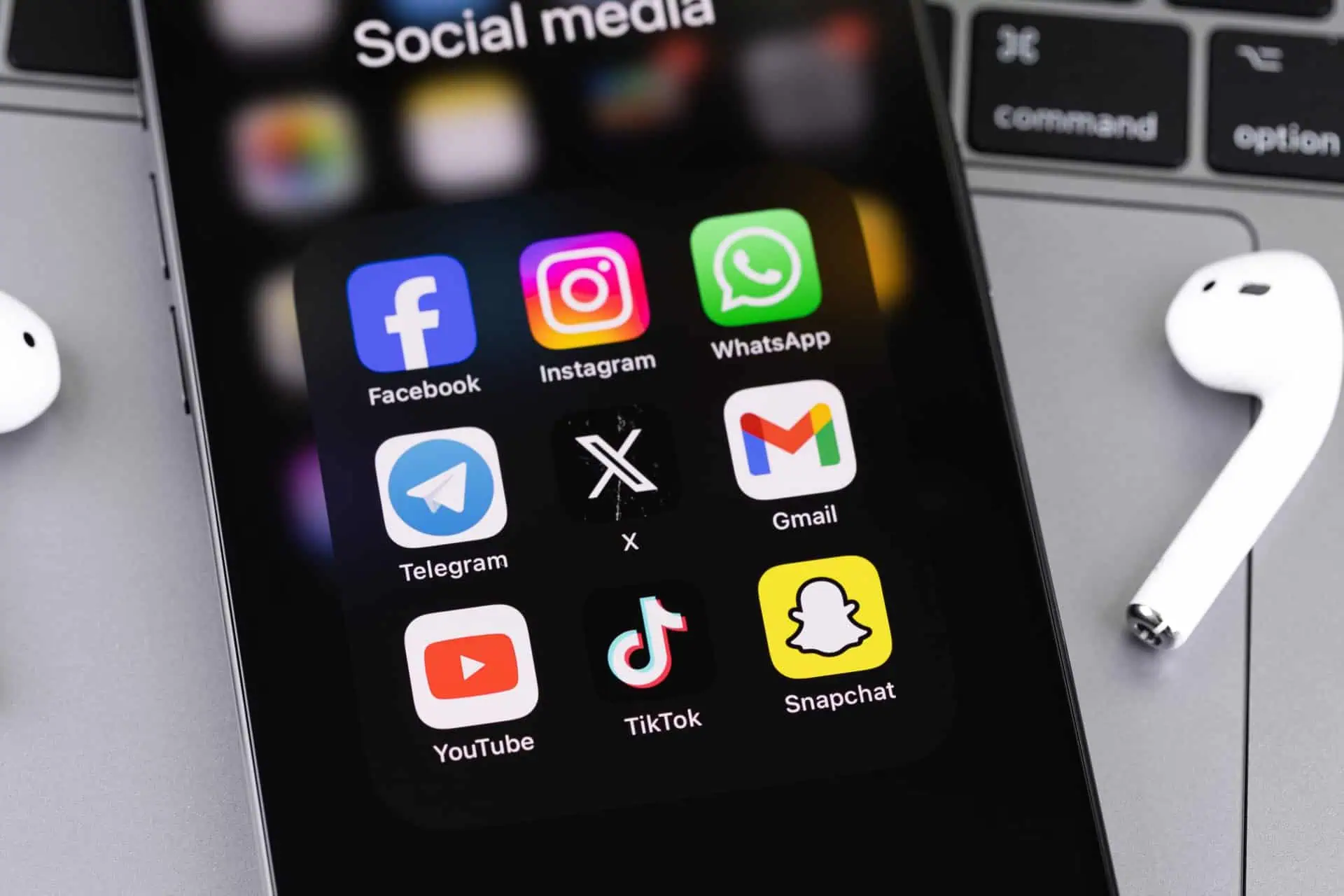Social Media Harm Lawsuits: Historical Precedence
- Last Updated: June 12th, 2025

Attorney Jessica Paluch-Hoerman, founder of TruLaw, has over 28 years of experience as a personal injury and mass tort attorney, and previously worked as an international tax attorney at Deloitte. Jessie collaborates with attorneys nationwide — enabling her to share reliable, up-to-date legal information with our readers.
Legally Reviewed
This article has been written and reviewed for legal accuracy and clarity by the team of writers and legal experts at TruLaw and is as accurate as possible. This content should not be taken as legal advice from an attorney. If you would like to learn more about our owner and experienced injury lawyer, Jessie Paluch, you can do so here.
Fact-Checked
TruLaw does everything possible to make sure the information in this article is up to date and accurate. If you need specific legal advice about your case, contact us by using the chat on the bottom of this page. This article should not be taken as advice from an attorney.
Key takeaways:
- Plaintiffs' in social media lawsuits claim that platform designs prioritize user engagement potentially at the cost of well-being.
- These lawsuits highlight a growing demand for transparency and accountability in curbing the spread of harmful content online.
- Legal actions against social media companies symbolize a greater push for corporate accountability in tech.
Overview Of Social Media Harm Lawsuits
On this page, we’ll discuss an overview of social media harm lawsuits, the historical precedence of litigation against social media companies, the types of damages plaintiffs can pursue in social media addiction lawsuits, and much more.
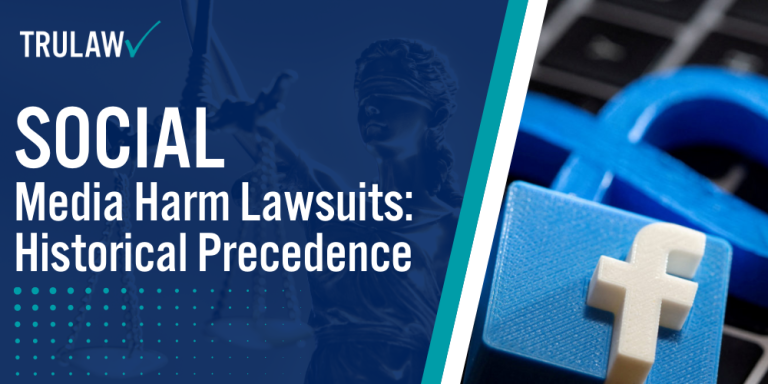
Intro To Social Media Harm Lawsuits
Here are some of the key issues raised in social media harm lawsuits:
- Algorithms designed to keep users engaged, leading to excessive screen time
- Inadequate safeguards against harmful content, such as cyberbullying and self-harm promotion
- Lack of transparency about the potential risks associated with social media use
- Insufficient age verification measures to protect underage users
If you or a loved one has suffered mental health issues, addiction, or other harm due to social media use, you may qualify to pursue compensation.
Contact TruLaw using the chat on this page to receive an instant case evaluation to determine if you qualify to file a social media harm lawsuit today.
Table of Contents
The Rise of Social Media Harm Lawsuits and Its Impact on Society
Social media’s vast expansion has prompted an increase in social media lawsuits blaming platforms for adverse mental health outcomes.
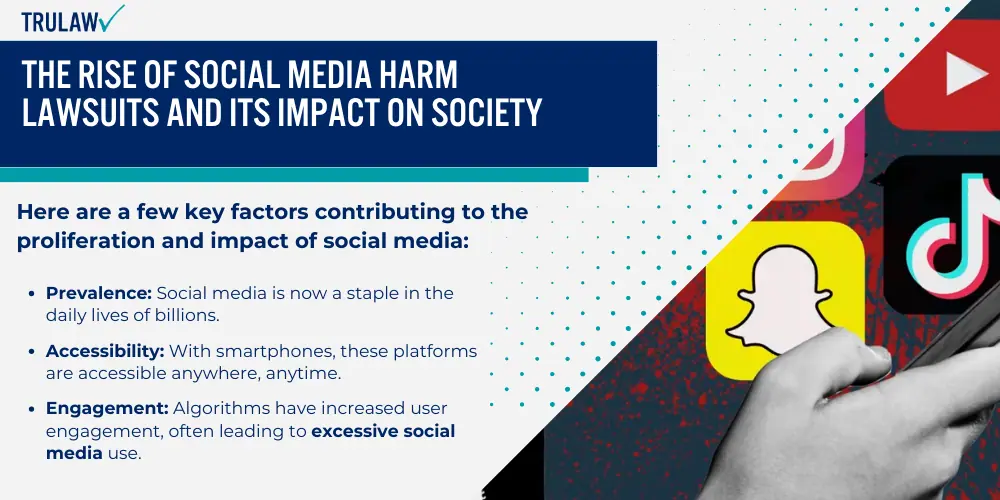
This development marks a significant turn in how society contends with the repercussions of the digital age.
The Rapid Growth of Social Media Platforms
Since their conception, social media platforms have experienced explosive growth, transforming from niche online communities into global powerhouses.
The ubiquity of platforms like Facebook, Instagram, and TikTok is a testament to this meteoric rise.
Here are a few key factors contributing to the proliferation and impact of social media:
- Prevalence: Social media is now a staple in the daily lives of billions.
- Accessibility: With smartphones, these platforms are accessible anywhere, at any time.
- Engagement: Algorithms have increased user engagement, often leading to excessive social media use.
- Variety: New social media apps continually enter the market, fighting for user attention.
Social networking sites now hold a central place in modern communication, entertainment, and even commerce.
The Influence of Social Media on Mental Health and Well-being
The impact of popular social media platforms on mental health has garnered attention from both researchers and the general public.
The relation between social media use and mental well-being is complex, with studies highlighting both positive and negative effects.
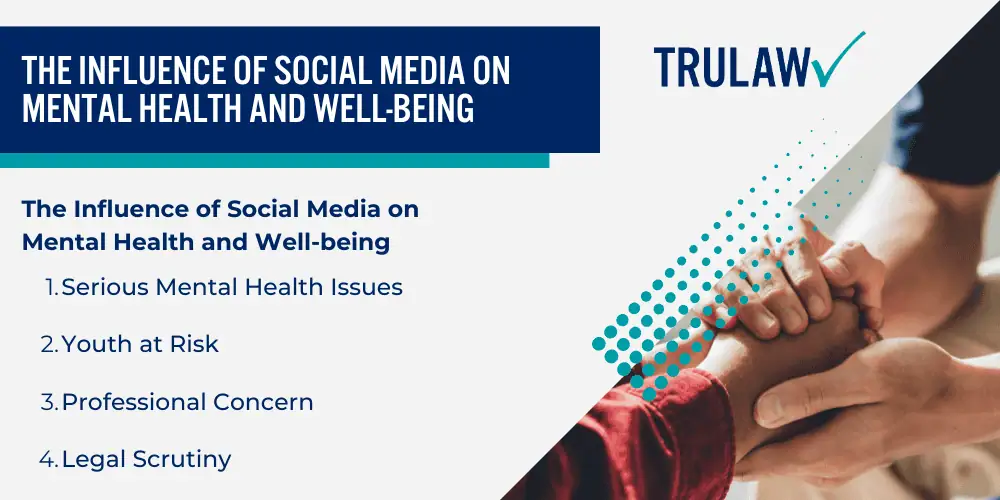
Exploring this issue further, several key areas highlight the breadth and depth of social media’s influence on mental health:
- Serious Mental Health Issues: Frequent social media usage has been linked to depression, anxiety, and other mental health conditions.
- Youth at Risk: The younger demographic is particularly vulnerable to the effects of poor mental health stemming from digital interactions.
- Professional Concern: Mental health professionals are increasingly encountering clients with mental health problems related to social media use.
- Legal Scrutiny: Lawsuits are beginning to question whether social media platforms should be held accountable for their users’ physical and mental health.
These factors have set the stage for social media harm lawsuits to emerge as a new phenomenon, reflecting society’s growing concerns about the digital environment’s impact on individual well-being.
Early Lawsuits Against Social Media Companies
Within the legal landscape, some of the pioneering cases have specifically examined the potential consequences of social media use.
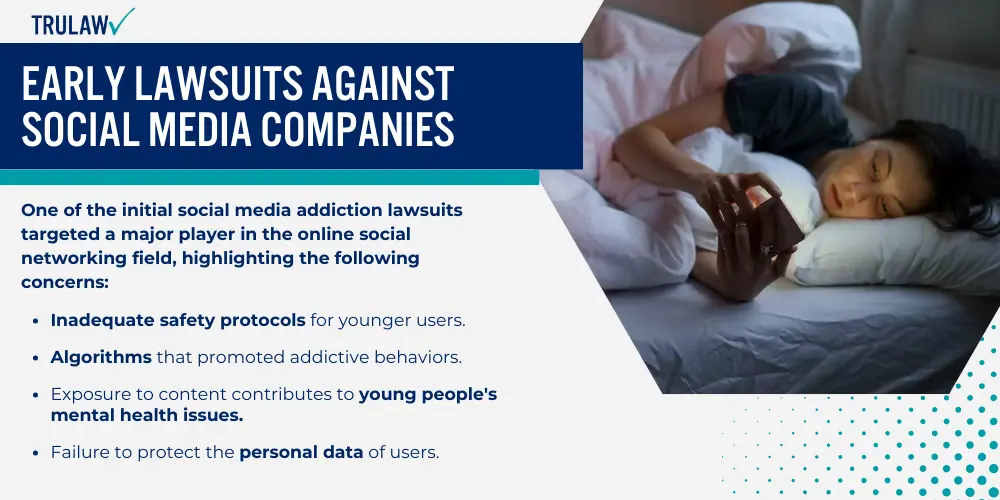
These lawsuits have addressed questions about the responsibility social media companies might hold regarding social media harm.
The First Cases Alleging Harm Caused by Social Media
The initiation of legal action against social media sites marked a significant moment in addressing the concerns around problematic social media use.
One of the initial social media addiction lawsuits targeted a major player in the online social networking field, highlighting the following concerns:
- Inadequate safety protocols for younger users.
- Algorithms that promoted addictive behaviors.
- Exposure to content contributes to young people’s mental health issues.
- Failure to protect the personal data of users.
The legal basis for these cases often hinged on the argument that social media sites were not merely neutral platforms but played an active role in how content was disseminated and how users interacted with the service.
Challenges in Proving Causation and Liability
Establishing a direct link between social media accounts and harm has presented particular challenges for the plaintiffs.
Key hurdles included:
- Demonstrating a direct causation between the platform’s design and the alleged harm.
- Overcoming legal protections afforded to social media companies under laws like Section 230 of the Communications Decency Act, which typically shields them from liability for user-generated content.
- Collecting concrete evidence that social media use specifically led to negative consequences.
- Articulating a precise definition of problematic social media use that the courts could agree on.
These cases have set a precedent, as they question to what extent social media entities should account for the potential negative impacts of their platforms on users’ well-being.
Landmark Social Media Harm Lawsuits
In recent years, several high-profile lawsuits have scrutinized the responsibilities of social media companies for harm caused to users.
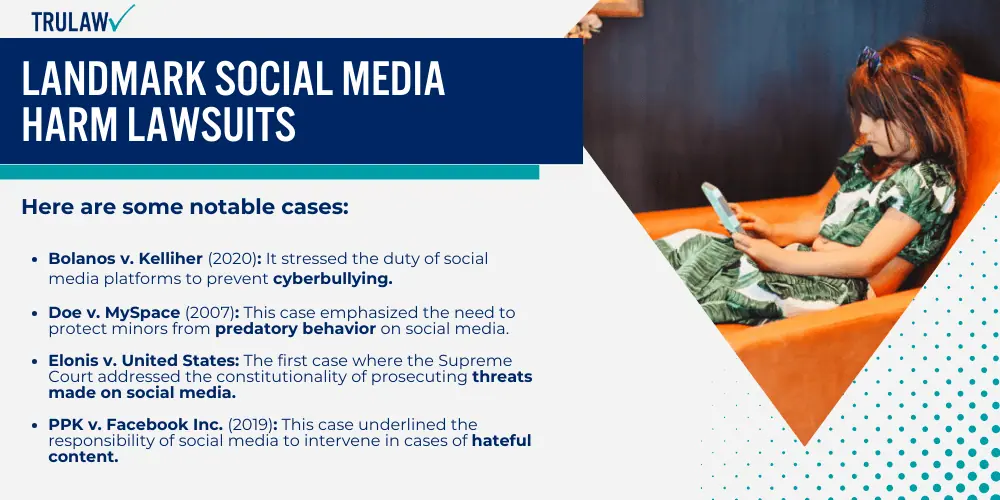
They have highlighted the tension between user safety and digital freedom.
Cases That Set Important Legal Precedents
Legal precedents are critical in shaping how social media companies operate.
Here are some notable cases:
- Bolanos v. Kelliher (2020): It stressed the duty of social media platforms to prevent cyberbullying.
- Doe v. MySpace (2007): This case emphasized the need to protect minors from predatory behavior on social media.
- Elonis v. United States: The first case where the Supreme Court addressed the constitutionality of prosecuting threats made on social media.
- PPK v. Facebook Inc. (2019): This case underlined the responsibility of social media to intervene in cases of hateful content.
Each case has delved into the legal requirements for social media companies to safeguard users from different aspects of online harm.
The Outcomes and Implications of These Lawsuits
The outcomes of these lawsuits underscore a pivotal shift in how digital platforms are governed and the responsibility they bear toward their users.
The results of these lawsuits have significant implications for social media platforms:
- Stringent Moderation: Social media giants are now more accountable for monitoring and moderating harmful content.
- Policy Changes: Resulted in changes to the terms of service and community guidelines to address the issues of harm.
- Technological Measures: Encouraged the development of advanced algorithms and AI tools to detect and prevent potential harm.
- Legal Disclosures: Compelled platforms to disclose data on how they handle reports of abuse and harassment.
Each outcome contributes to a broader understanding of the balance between free speech and protection from harm in the digital space.
The Legal Basis for Social Media Harm Lawsuits
The rise of social media has led to a wave of litigation as social media attorneys argue that these platforms have knowingly enabled harm to users, particularly minors.
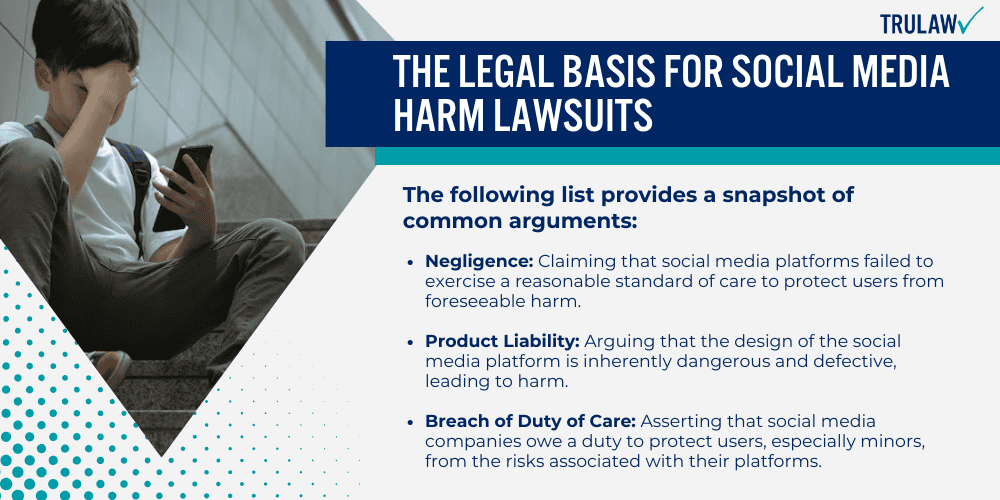
In pursuing justice, lawyers are formulating legal strategies that may reshape the responsibilities of tech companies.
Theories of Liability in Social Media Harm Lawsuits
Legal discussions often focus on the specific theories under which social media companies can be held accountable for user harm.
The following list provides a snapshot of common arguments:
- Negligence: Claiming that social media platforms failed to exercise a reasonable standard of care to protect users from foreseeable harm.
- Product Liability: Arguing that the design of the social media platform is inherently dangerous and defective, leading to harm.
- Breach of Duty of Care: Asserting that social media companies owe a duty to protect users, especially minors, from the risks associated with their platforms.
- Misrepresentation: Contending that social media entities falsely advertised their products as safe, or failed to disclose their harmful aspects.
The Role of Section 230 of the Communications Decency Act
Another pivotal legal aspect in these lawsuits is the role of Section 230 of the Communications Decency Act (CDA 230).
This legislation has traditionally shielded platforms from liability for the content posted by their users.
However, recent lawsuits are challenging the extent of this immunity, particularly in cases where the platform’s design and algorithms may contribute to the harm.
The following points highlight key aspects of CDA 230 in relation to social media harm lawsuits:
- Social media companies have generally been considered as platforms rather than publishers, which grants them certain protections under CDA 230.
- Plaintiffs are challenging the scope of this protection, arguing that algorithmic promotion of harmful content goes beyond passive hosting.
- There is ongoing debate about whether social media platforms’ actions in curating and recommending content could establish them as content creators.
- Some lawsuits are pressing for a reinterpretation or amendment of CDA 230 to hold social media platforms more accountable for user harm.
The Evolving Landscape of Social Media Regulation
The regulation of social media platforms is adapting rapidly to address the dual needs of protecting online users and upholding free speech, creating a dynamic legal environment.
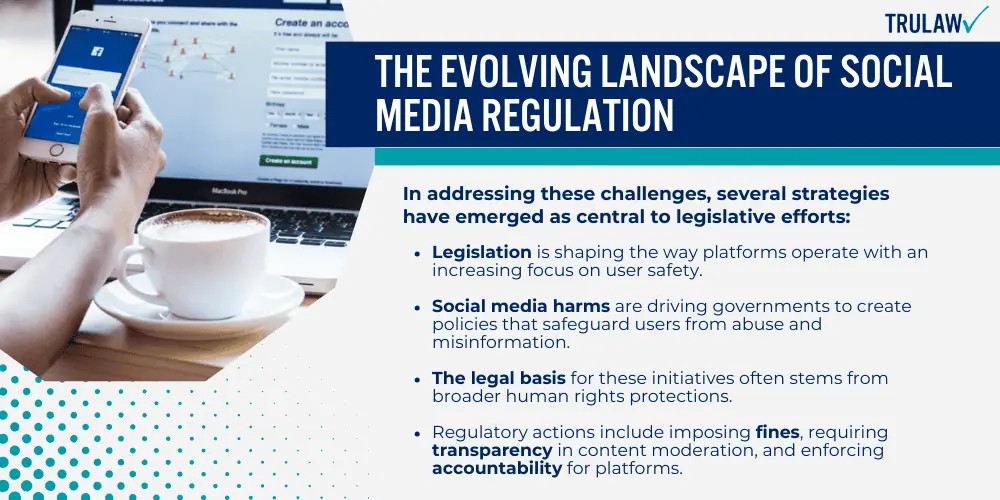
Legislative Efforts to Address Social Media Harms
Bold legislatures worldwide are actively pursuing measures to reduce online harm, striving to balance them with the rights of users.
This drive is influenced by the growing concerns over the negative effects social media can have on individuals and societies.
In addressing these challenges, several strategies have emerged as central to legislative efforts:
- Legislation is shaping the way platforms operate with an increasing focus on user safety.
- Social media harms are driving governments to create policies that safeguard users from abuse and misinformation.
- The legal basis for these initiatives often stems from broader human rights protections.
- Regulatory actions include imposing fines, requiring transparency in content moderation, and enforcing accountability for platforms.
The Debate Over Social Media Company Responsibility
There is an ongoing conversation about the level of responsibility social media companies should bear for the content on their platforms.
At the heart of this discourse are several critical points of contention:
- Platforms are often viewed as curators of content, raising questions about their role in managing user posts.
- Online users are affected by the actions these companies take to regulate or not regulate content.
- Social media harm is a significant driver for demanding greater accountability from these companies.
- Debates are centered on whether liability shields, such as those provided by Section 230 of the Communications Decency Act in the US, should remain intact or be reformed.
The Impact of Social Media Harm Lawsuits on the Industry
Recent lawsuits are prompting social media companies to reassess how their platforms affect users, particularly young people.
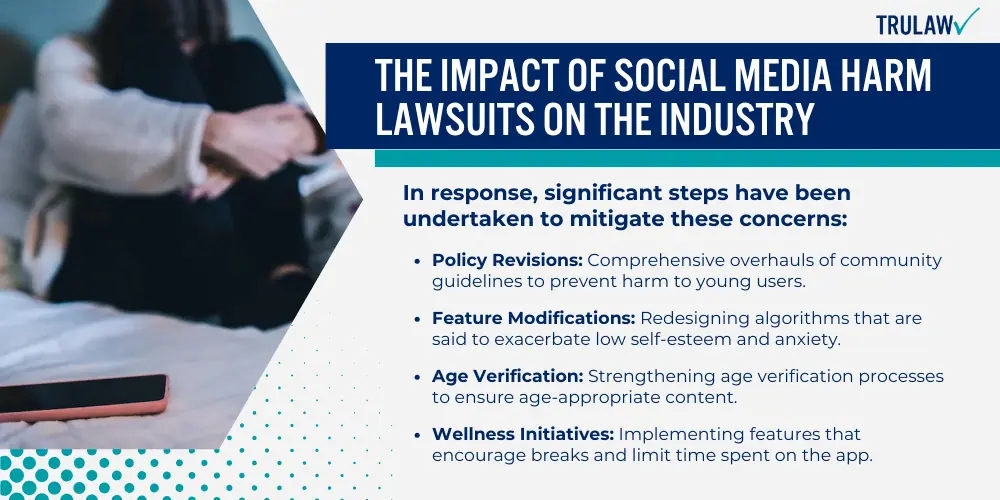
These legal actions underscore the need for change to protect users’ emotional well-being and self-esteem.
Changes in Platform Policies and Practices
Social media sites are being forced to reevaluate their policies and practices in the wake of litigation.
The lawsuits allege that certain features of social media apps have a negative impact on the physical health and mental wellness of young adults and children.
In response, significant steps have been undertaken to mitigate these concerns:
- Policy Revisions: Comprehensive overhauls of community guidelines to prevent harm to young users.
- Feature Modifications: Redesigning algorithms that are said to exacerbate low self-esteem and anxiety.
- Age Verification: Strengthening age verification processes to ensure age-appropriate content.
- Wellness Initiatives: Implementing features that encourage breaks and limit time spent on the app.
Increased Scrutiny and Public Awareness of Social Media Harms
The filings have made the public more aware of the potential risks associated with social media accounts.
The increased scrutiny from the public and governments is putting pressure on social media companies.
To address this growing concern, several measures have been adopted by social media companies:
- Transparency Reports: Social media apps now release reports detailing their efforts to mitigate harm.
- Investment in Research: There’s a move towards funding independent studies on the long-term effects of social media use.
- Public Disclosures: Legislations are being considered to compel disclosures about the effects of algorithms.
- Educational Campaigns: Launching of awareness campaigns to inform users of the potential negative impacts of social media.
The Future of Social Media Harm Lawsuits
As legal social media challenges evolve and society’s reliance on digital platforms grows, the landscape of social media litigation is poised to expand.
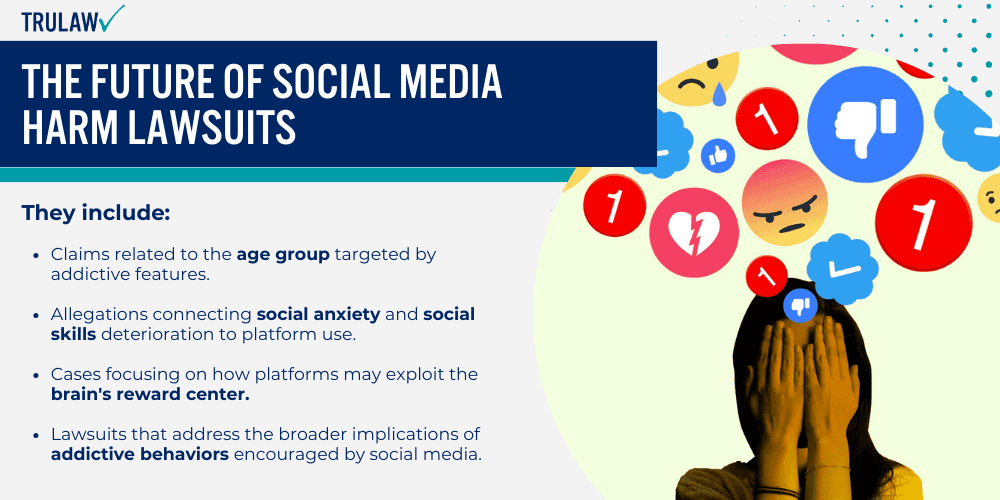
The upcoming trends and specific causes of action will set the stage for complex debates balancing individual rights and corporate responsibilities.
Emerging Trends and Potential New Causes of Action
The legal climate around social media is constantly adapting with new potential causes of action emerging.
They include:
- Claims related to the age group targeted by addictive features.
- Allegations connecting social anxiety and social skills deterioration to platform use.
- Cases focusing on how platforms may exploit the brain’s reward center.
- Lawsuits that address the broader implications of addictive behaviors encouraged by social media.
These developments reflect a growing concern over the potential long-term effects of social platforms on users’ mental health and behavior.
The Importance of Balancing Free Speech and User Protection
The discourse surrounding social media harm lawsuits must also consider the balance of free speech and user protection.
Key points in this dialogue include:
- The necessity to protect free speech as a fundamental right while ensuring social media spaces do not harm users.
- The challenge of creating algorithms and platform policies that safeguard against speech that potentially leads to addictive behavior without stifling user expression.
- The exploration of how platforms might transparently manage addictive social media features while upholding users’ protection.
- There is a potential need for regulations that help delineate the boundaries of responsible platform operation in the context of user wellbeing and societal impact.
Social media harm lawsuits are anticipated to more precisely define the relationship between technology providers and the welfare of their users moving forward.
Lessons Learned from Historical Social Media Harm Lawsuits
Historical Social Media Harm Lawsuits have illuminated valuable insights into the double-edged nature of social networks.
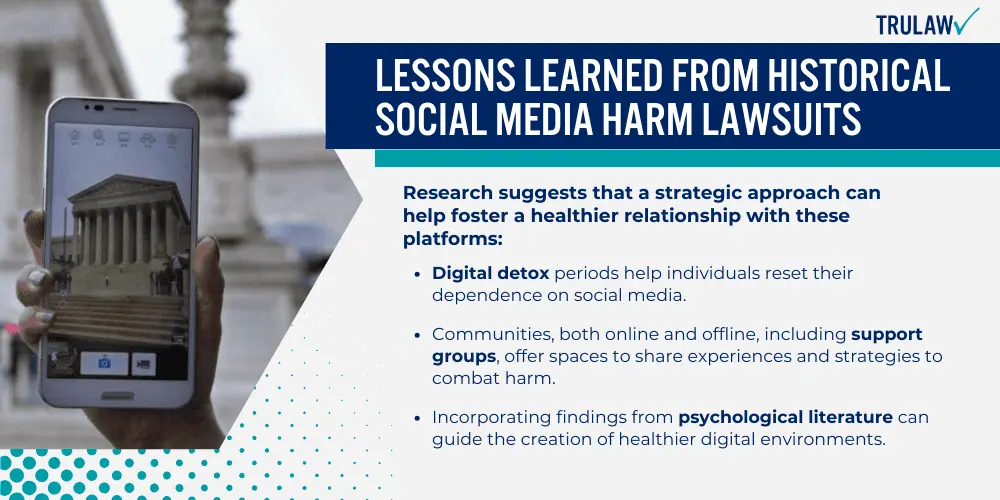
They’ve shown the necessity for robust proactive measures and a united effort among different parties to mitigate potential harms.
The Need for Proactive Measures to Mitigate Risks
Proactive measures are essential to counter the negative effects of social media on individuals’ mental health.
Research suggests that a strategic approach can help foster a healthier relationship with these platforms:
- Digital detox periods help individuals reset their dependence on social media.
- Communities, both online and offline, including support groups, offer spaces to share experiences and strategies to combat harm.
- Incorporating findings from psychological literature can guide the creation of healthier digital environments.
- Educational campaigns on the risks of social media encourage informed user participation.
Proactive measures need to be ingrained within the user experience of social media to mitigate risks effectively.
The Importance of Collaboration Between Stakeholders to Address Harms
Collaboration is key to addressing the breadth of challenges posed by social media.
Diverse parties, from corporations to healthcare professionals, play roles in this:
- Large national surveys can reveal patterns in social media harm, facilitating effective responses.
- Policymakers and platform designers must work together to implement safeguards and regulations.
- Professional help for dealing with particularly severe cases of negative effects, such as low self-esteem or body image issues.
- We are developing tools for users to maintain a healthy balance in everyday life, enhancing positive feedback mechanisms without falling prey to the loop of seeking constant validation.
Collaboration between stakeholders is necessary to address harm and prevent them from integrating into users’ everyday lives.
TruLaw: #1 Social Media Harm Lawsuit Attorneys
TruLaw stands as a leading law firm dedicated to representing individuals in social media harm lawsuits.
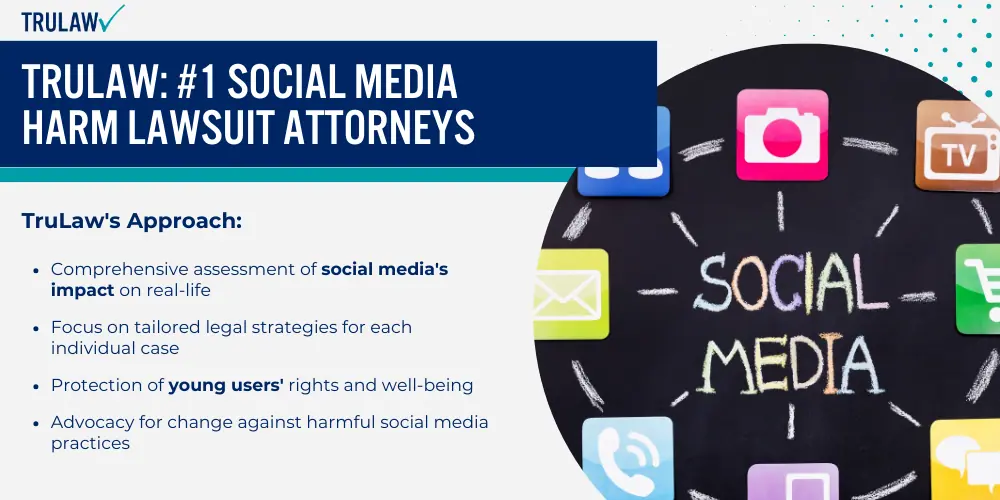
They have established themselves notably through their work with cases pertaining to the negative impact of constant social media interaction.
TruLaw’s Approach:
- Comprehensive assessment of social media’s impact on real-life
- Focus on tailored legal strategies for each individual case
- Protection of young users’ rights and well-being
- Advocacy for change against harmful social media practices
Key Achievements:
- Secured settlements which reflect their priority to hold platforms accountable
- Pioneered legal strategies that address the flux of the digital landscape
- Provided a steady stream of legal resources for affected families
- Maintained a strong track record in litigating social media-related cases
Their team remains committed to addressing the effects on real life that come from the pervasive use of social media.
The attorneys at TruLaw diligently ensure that each social media addiction lawsuit reflects the individual nature of a client’s experience, demonstrating a meticulous understanding of the intricacies digital platforms present.
They work under the fact that there is a fine line between engaging content and content that leads to detrimental outcomes.
Focusing on this area, TruLaw aids those who have experienced harm, particularly young users who are more susceptible to the aggressive tactics social media companies often employ.
The firm’s efforts have not only brought relief to many individuals but also increased awareness about the responsibility of social media platforms.
With each case, TruLaw reinforces its position at the forefront of championing the rights of users against powerful tech companies.
Social Media Harm Lawsuits Frequently Asked Questions
-
What are the grounds for filing a class action social media lawsuit?
Class action lawsuits against social media companies often cite negligence, breach of consumer protection laws, and the knowing provision of addictive features harmful to minors.
These lawsuits argue that companies prioritize profit over user safety.
-
How do social media platforms influence students' mental health, and can they be held liable?
Social media platforms can influence students mental health by exacerbating feelings of inadequacy, anxiety, and depression through curated content and comparison.
Liability arises if they fail to warn users or mitigate known risks associated with their services.
-
What are the typical compensation amounts awarded in successful social media harm lawsuits?
Compensation in social media harm lawsuits typically depends on the nature and extent of damage experienced.
It can range from thousands to millions of dollars, including both actual damages and punitive damages.
-
Can schools take legal action against social media companies for affecting student well-being?
Schools may take legal action if they can demonstrate that a social media company’s actions have directly caused harm that affects student well-being and hamper the educational environment.
Precedent in these kinds of cases is still emerging.
-
How do you legally address social media addiction claims against major platforms?
To legally address social media addiction claims, one must provide evidence of the platform’s compulsive use, demonstrate harmful consequences, and prove the company’s knowledge and neglect of such effects.
-
Under what circumstances can an individual sue for defamation on social media?
An individual can sue for defamation if false statements are published on social media, causing reputational damage, provided that the statements were made with negligence or malice and there was no valid defense like truth or opinion.

Managing Attorney & Owner
With over 25 years of legal experience, Jessica Paluch-Hoerman is an Illinois lawyer, a CPA, and a mother of three. She spent the first decade of her career working as an international tax attorney at Deloitte.
In 2009, Jessie co-founded her own law firm with her husband – which has scaled to over 30 employees since its conception.
In 2016, Jessie founded TruLaw, which allows her to collaborate with attorneys and legal experts across the United States on a daily basis. This hypervaluable network of experts is what enables her to share the most reliable, accurate, and up-to-date legal information with our readers!
Additional Social Media Harm Lawsuits resources on our website:
Here, at TruLaw, we’re committed to helping victims get the justice they deserve.
Alongside our partner law firms, we have successfully collected over $3 Billion in verdicts and settlements on behalf of injured individuals.
Would you like our help?
At TruLaw, we fiercely combat corporations that endanger individuals’ well-being. If you’ve suffered injuries and believe these well-funded entities should be held accountable, we’re here for you.
With TruLaw, you gain access to successful and seasoned lawyers who maximize your chances of success. Our lawyers invest in you—they do not receive a dime until your lawsuit reaches a successful resolution!
AFFF Lawsuit claims are being filed against manufacturers of aqueous film-forming foam (AFFF), commonly used in firefighting.
Claims allege that companies such as 3M, DuPont, and Tyco Fire Products failed to adequately warn users about the potential dangers of AFFF exposure — including increased risks of various cancers and diseases.
Depo Provera Lawsuit claims are being filed by individuals who allege they developed meningioma (a type of brain tumor) after receiving Depo-Provera birth control injections.
A 2024 study found that women using Depo-Provera for at least 1 year are five times more likely to develop meningioma brain tumors compared to those not using the drug.
Suboxone Tooth Decay Lawsuit claims are being filed against Indivior, the manufacturer of Suboxone, a medication used to treat opioid addiction.
Claims allege that Indivior failed to adequately warn users about the potential dangers of severe tooth decay and dental injuries associated with Suboxone’s sublingual film version.
Social Media Harm Lawsuits are being filed against social media companies for allegedly causing mental health issues in children and teens.
Claims allege that companies like Meta, Google, ByteDance, and Snap designed addictive platforms that led to anxiety, depression, and other mental health issues without adequately warning users or parents.
Transvaginal Mesh Lawsuits are being filed against manufacturers of transvaginal mesh products used to treat pelvic organ prolapse (POP) and stress urinary incontinence (SUI).
Claims allege that companies like Ethicon, C.R. Bard, and Boston Scientific failed to adequately warn about potential dangers — including erosion, pain, and infection.
Bair Hugger Warming Blanket Lawsuits involve claims against 3M — alleging their surgical warming blankets caused severe infections and complications (particularly in hip and knee replacement surgeries).
Plaintiffs claim 3M failed to warn about potential risks — despite knowing about increased risk of deep joint infections since 2011.
Baby Formula NEC Lawsuit claims are being filed against manufacturers of cow’s milk-based baby formula products.
Claims allege that companies like Abbott Laboratories (Similac) and Mead Johnson & Company (Enfamil) failed to warn about the increased risk of necrotizing enterocolitis (NEC) in premature infants.
Here, at TruLaw, we’re committed to helping victims get the justice they deserve.
Alongside our partner law firms, we have successfully collected over $3 Billion in verdicts and settlements on behalf of injured individuals.
Would you like our help?
